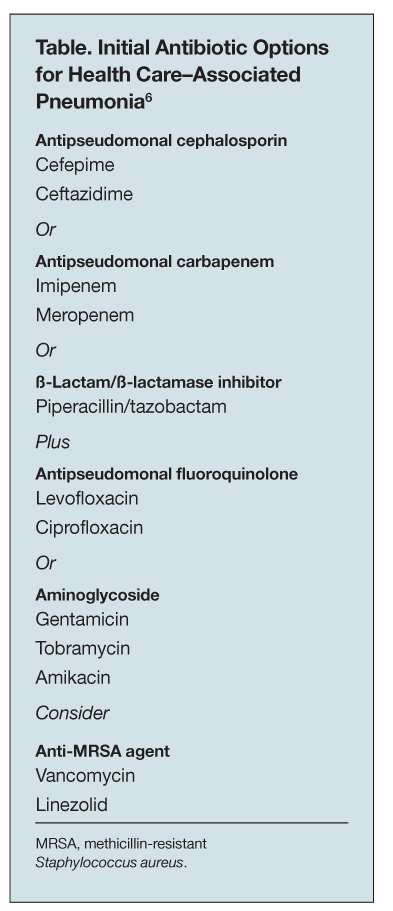- Clinical Technology
- Adult Immunization
- Hepatology
- Pediatric Immunization
- Screening
- Psychiatry
- Allergy
- Women's Health
- Cardiology
- Pediatrics
- Dermatology
- Endocrinology
- Pain Management
- Gastroenterology
- Infectious Disease
- Obesity Medicine
- Rheumatology
- Nephrology
- Neurology
- Pulmonology
Health Care–Associated Pneumonia
Health care–associated pneumonia (HCAP) is a relatively new term used to describe pneumonia that develops in patients who have recently been exposed to nosocomial and drug-resistant pathogens as a result of hospitalization or residence in a nursing home, for example. A recent study found that about 25% of patients hospitalized with pneumonia had HCAP, and that the mortality rate was higher in those with HCAP than in those with community-acquired pneumonia (CAP).
Health care–associated pneumonia (HCAP) is a relatively new term used to describe pneumonia that develops in patients who have recently been exposed to nosocomial and drug-resistant pathogens as a result of hospitalization or residence in a nursing home, for example. A recent study found that about 25% of patients hospitalized with pneumonia had HCAP, and that the mortality rate was higher in those with HCAP than in those with community-acquired pneumonia (CAP).1

Because multidrug-resistant pathogens are more common in HCAP than in CAP, the initial therapy for HCAP is similar to that for hospital-acquired pneumonia (Table). The results of a study in Japan underscore the importance of differentiating between HCAP and CAP. Shindo and associates2 studied 141 patients with HCAP and 230 patients with CAP. The proportion of patients with pneumonia classified as severe was higher in the HCAP group than in the CAP group.
Among patients with pneumonia of moderate severity, HCAP was associated with higher in-hospital mortality-11.1%, compared with 1.9% for CAP. Among patients with pneumonia of moderate severity, potentially antibiotic-resistant pathogens, such as Pseudomonas aeruginosa and other Gram-negative bacteria, methicillin-resistant Staphylococcus aureus, and streptococci other than Streptococcus pneumoniae, were isolated more frequently in those with HCAP (22.2%) than in those with CAP (1.9%). The presence of potentially resistant pathogens was associated with inappropriate initial therapy and initial treatment failure.
The investigators conclude that potentially resistant pathogens should be considered when selecting initial antibiotic therapy for patients with HCAP. They suggest that broad-spectrum antibiotics-such as an antipseudomonal b-lactam plus a fluoroquinolone or an aminoglycoside plus vancomycin or linezolid-would be appropriate even in patients whose pneumonia is not classified as severe.
However, a different conclusion was reached by Brito and Niederman,3 who evaluated 8 studies on HCAP and 3 prospective randomized trials of nursing home–acquired pneumonia. They found that many patients were successfully treated with monotherapy or with regimens that are generally used for CAP. They attribute this to the fact that not all of the patients with HCAP had risk factors for infection with multidrug- resistant pathogens. Patients who were at risk for multidrug resistance were those who were severely ill or had other risk factors, such as hospitalization in the past 90 days, antibiotic therapy in the past 6 months, poor functional status, and immunosuppression.
Brito and Niederman3 concluded that not all patients with HCAP require a broad-spectrum multidrug regimen. Additional support for this conclusion comes from findings reported by El Solh and associates,4 who retrospectively studied 334 patients with nursing home–acquired pneumonia. Patients were classified according to whether they were treated following the 2003 guidelines for CAP5 or the 2005 guidelines for HCAP.6 The 2 groups did not differ significantly with respect to time to clinical stability and adjusted in-hospital and 30-day mortality rates. However, patients treated according to the HCAP guidelines did have a longer time to “switch therapy” and a longer length of stay.
References:
References
1. Venditti M, Falcone M, Corrao S, et al; Study Group of the Italian Society of Internal Medicine. Outcomes of patients hospitalized with community-acquired, health care-associated, and hospital-acquired pneumonia. Ann Intern Med. 2009;150:19-26.
2. Shindo Y, Sato S, Maruyama E, et al. Health-careâassociated pneumonia among hospitalized patients in a Japanese community hospital. Chest. 2009;135:633-640.
3. Brito V, Niederman MS. Healthcare-associated pneumonia is a heterogeneous disease, and all patients do not need the same broad-spectrum antibiotic therapy as complex nosocomial pneumonia. Curr Opin Infect Dis. 2009;22:316-325.
4. El Solh AA, Akinnusi ME, Alfarah Z, Patel A. Effect of antibiotic guidelines on outcomes of hospitalized patients with nursing homeâacquired pneumonia. Am Geriatr Soc. 2009;57:1030-1035. 5. Mandell LA, Bartlett JG, Dowell SF, et al; Infectious Diseases Society of America. Update of practice guidelines for the management of community-acquired pneumonia in immunocompetent adults. Clin Infect Dis. 2003;37:1405-1433.
6. American Thoracic Society; Infectious Diseases Society of America. Guidelines for the management of adults with hospital-acquired, ventilator-associated, and healthcare-associated pneumonia. Am J Respir Crit Care Med. 2005;171:388-416.
